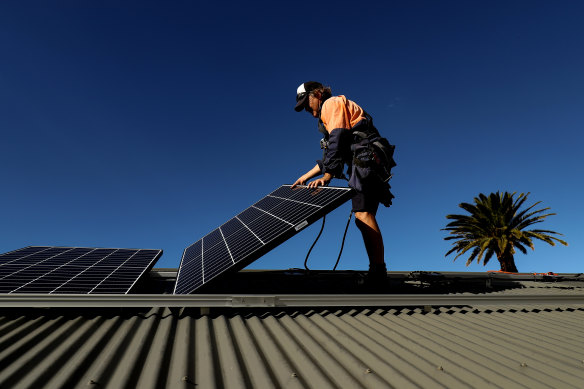- Exclusive
- Politics
- Federal
- Renewables
This was published 4 months ago
Half an hour of power: Renewables’ record surge a sign of future supply
By Mike Foley and Nick Toscano
The nation’s east coast power grid has notched a record-breaking half-hour of running on 72 per cent renewable energy – a major milestone in the transition away from burning fossil fuels – but significant upgrades are needed to handle bigger and longer bursts of clean energy.
Two engineering updates from the Australian Energy Market Operator (AEMO), to be released on Thursday, say the nation’s eastern and western power grids are edging closer to being able to operate at higher contributions of renewable energy.

Reforms to better integrate rooftop solar panels and electric vehicles into the grid are key to boosting the share of renewables in the electricity grid. Credit: Bloomberg
Renewables on average now accounted for 40 per cent of supply in the eastern states’ grid, the AEMO reports say, and are peaking at “world-leading” levels above 72 per cent for short bursts.
In one 30-minute interval last December, rooftop solar provided more than 100 per cent of South Australia’s entire underlying demand.
The share of power generated from the sun, wind and water is expanding each year in Australia as coal-fired generators that supply the bulk of the country’s electricity fast-forward their closure dates.
However, more work is required to drive the shift to clean power such as better managing the influx of rooftop solar or finding ways to tap electric vehicles’ batteries for critical injections of power into the grid.
“AEMO must be ready to operate the power system under all foreseeable conditions, including during periods of world-leading contribution from rooftop solar and grid-scale renewable energy,” AEMO chief executive Daniel Westerman said.
“We are working with leading international peers and local industry to remove the technical constraints to harnessing more renewable energy for the benefit of Australian homes and businesses,” he said.
AEMO, which oversees the interstate power and gas markets, is delivering a major engineering program to make sure the grid remains reliable, without the risk of blackouts or disruptions to power supply, even as the share of fluctuating wind and solar power generation soars.
Last year, an average of 7 per cent of east-coast electricity came from large-scale solar farms, 13 per cent from wind turbines and 12 per cent from rooftop solar panels.
More than 3 million homes – or one in three – are now fitted with solar panels, the highest per-capita take-up rate of any nation.
However, with solar power flooding the market with abundant electricity in the middle of the day before receding in the evenings, grid planners must ensure the system remains secure and avoids dangerous spikes in voltage levels.
AEMO expects household solar panels to be on 80 per cent of Australian households by 2050, making it an increasingly significant form of electricity generation.
That’s why the nation’s energy ministers last month signed off on a plan that would standardise their inverters. These devices convert the direct current electricity generated by solar panels into the alternating current that operates on the grid.
The new standards would ensure inverters remain connected to the grid if the network is disrupted.
In February, gale-force winds downed high-voltage power lines and left 130,000 homes without power, effectively tripping a fuse that connected the grid to the Loy Yang A brown coal plant.
The energy minister’s council plans also included an agreement to set up nationally consistent rules for electric vehicles to export power stored in their batteries back into the grid, and potentially earn money for doing so.
A world-first Australian trial proved, in February this year, that electric vehicles fitted with appropriate technology at the point of charging can detect a disruption in the grid’s electricity supply and send power back into the network.
Cut through the noise of federal politics with news, views and expert analysis. Subscribers can sign up to our weekly Inside Politics newsletter.